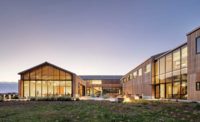Chapel Hill, North Carolina
To attract the best and brightest faculty and students, universities today are asking architects for buildings that not only serve their academic goals but also bring prestige to their campuses through innovative design. The Genome Sciences Building (GSB) at the University of North Carolina (UNC) in Chapel Hill succeeds on both levels. Designed by the Chicago office of Skidmore, Owings & Merrill (SOM), the GSB is an integral part of the university’s Bell Tower District, for which the firm designed the master plan in 2004. “The resulting plan serves as a vital link between the historic north campus and the medical school to the south, forming a series of new quadrangles, a park, and expansion of the existing Coker Woods,” explains SOM associate director Peter Van Vechten.“Conceived as an interdisciplinary ‘crossroads,’ the GSB unites scientific rigor with collaborative flexibility, supporting parallel research and teaching functions.”
“Porosity” and “transparency” are the words mentioned most often by the architects and users to describe both the architectural and programmatic goals of the GSB. The center emphasizes a shift from isolated closed-loop research to the open-ended, multidisciplinary collaboration that has become critical to cutting-edge science in the 21st century.
The eight-story 228,000-square-foot GSB rests on a plinth, clad in brick to acknowledge the traditional Georgian structures of the original campus. Students can enter classrooms and lecture halls off pedestrian paths at grade or follow a ramp to a public plaza atop the plinth where they can enjoy landscaped and shaded areas and a café.
The plinth and facility rising from it posed significant structural challenges. The GSB is an L-shaped glass-and-concrete box housing wet and dry labs, faculty offices, conference rooms, and an enormous rooftop greenhouse for the study of plant genomics. The L is made of three pods, two of which extend two floors below grade to accommodate the mechanical plant. These pods rest on mat foundations that align with the natural slope of the bedrock. This arrangement minimized excavation and eliminated blasting. The third pod is supported at the plaza level by micropiles, 8 inches in diameter, which are often employed at sites with difficult access such as this one.
The building’s upper floors focus on three large wet labs. This organization allows three to five principal investigators to work together in each lab, with benches arranged to accommodate 30 people in the same lab space. Dry labs are adjacent to the wet ones, allowing researchers to go back and forth between different experiments. Faculty offices are next to the dry labs and cantilever from the upper floors.
The major interior-design strategy involves daylighting, which floods the labs through floor-to-ceiling glazing. Rather than adding drywall or paneling to the interior face of the perimeter walls, the architects saved money and achieved an industrial effect by simply tinting and polishing the concrete. Floors and interior partitions are rendered in sturdy low-maintenance materials. Against this economical backdrop, a dramatic spiral staircase emerges as the centerpiece of the interior. The stair is enclosed in a glass elliptical column, reinforcing the architect’s pursuit of transparency at every floor. It terminates at the 80-by-200-foot greenhouse, which, when lit at night, confirms the GSB’s status as an icon of innovation in the center of the campus.
“The simple, honest palette of materials—concrete, metal, and high-performance glazing—allows the GSB to maintain UNC’s longstanding commitment to sustainability,” says Van Vechten. In addition, the facility is fully integrated with the master plan for site development—re-using water for irrigation of the park, which itself is engineered to process stormwater and mitigate peak levels. SOM achieved this feat by installing underground cisterns with a 50,000-cubic-foot capacity. A reservoir tank collects roof drainage water, which silently and invisibly irrigates the gently graded park fronting the building. These water-conservation tactics, along with many energy-saving strategies, contributed to the GSB’s LEED Gold certification.
Genomics is a new field within the study of genetics, encompassing a broad range of inquiry from bioinformatics to engineering to medicine. With few precedents for this kind of complex programming, SOM designed a facility that embraces the multidisciplinary nature of 21st-century scientific research, education, and training. Going far beyond the goals of porosity and transparency, SOM delivered a programmatic and architectural model that will allow the university to respond to rapidly evolving technologies and to foresee opportunities for discovery for decades to come.
People
Owner:
Architect:
Personnel in architect's firm who should receive special credit:
Interior designer:
Engineer(s):
Skidmore, Owings & Merrill LLP Project Team:
Consultant(s):
Laboratory Design:
MEP/FP Design:
Stormwater Engineering:
Civil Engineering:
Lighting:
Acoustical:
Other:
General contractor:
Photographer(s):
Peter Van Vechten
Renderer:
CAD system, project management, or other software used: Size: 210,000 square feet Cost: $110 million Completion date: September 2012 |
Products
Structural system
Manufacturer of any structural components unique to this project
Exterior cladding
Metal Panels:
Custom Fabrication Contractor:
Metal/glass curtain wall:
Others:
Moisture barrier:
Curtain wall:
Others:
Roofing
Glazing
Skylights:
Doors
Metal doors:
Fire-control doors, security grilles:
Hardware Closers: Norton Exit devices: Sargent Pulls: Adams Rite, Blumcraft Security devices: Dorma
Interior finishes
Suspension grid:
Cabinetwork and custom woodwork:
Tabu Coporation ' Wood Veneer
Paints and stains:
Wall coverings:
Plastic laminate:
Floor and wall tile:
Resilient flooring: Carpet: Shaw Raised flooring: Tate
Special interior finishes unique to this project:
Furnishings
Office furniture:
Reception furniture:
Fixed seating:
Chairs:
Tables:
Upholstery:
Other furniture:
Lighting
Downlights: Task lighting: Bega
Exterior:
Dimming System or other lighting controls:
Conveyance
Plumbing
Energy
Add any additional building components or special equipment that made a significant contribution to this project: |
















